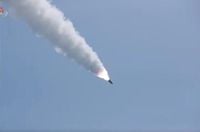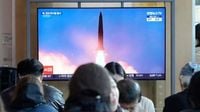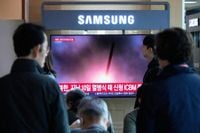North Korea has thrust itself back into the international spotlight by launching multiple short-range ballistic missiles off its eastern coast on October 22, 2025, just days before world leaders are scheduled to gather in South Korea for the Asia-Pacific Economic Cooperation (APEC) summit. The move, the first missile test in five months and the inaugural such event under South Korea’s new president Lee Jae Myung, comes at a time of heightened diplomatic activity and mounting regional tensions.
According to South Korea’s Joint Chiefs of Staff, the missiles were detected around 8:10 am local time, launched from an area south of Pyongyang, the North Korean capital. Each missile traveled approximately 350 kilometers (217 miles) in a northeastern direction before splashing down in the waters known as the East Sea or Sea of Japan (as reported by Yonhap and multiple international outlets). Japan’s Prime Minister Sanae Takaichi promptly reassured the public that none of the missiles landed in Japanese territorial waters or its exclusive economic zone, and there were no reports of damage. "Tokyo is closely communicating with Washington and Seoul, including by sharing real-time missile warning data," Takaichi told reporters, according to NBC News.
This latest launch marks the first time North Korea has fired ballistic missiles since May 8, 2025, when it tested short-range systems simulating nuclear counterstrikes against US and South Korean forces. Notably, it is also the first such provocation since Lee Jae Myung assumed the South Korean presidency in June, having campaigned on a platform of restoring peace to the Korean Peninsula. South Korea’s military has responded by stepping up monitoring and maintaining a "steadfast readiness posture" in close coordination with the United States and Japan, as stated by Seoul’s Joint Chiefs of Staff.
The timing of the missile launches appears far from coincidental. The Asia-Pacific Economic Cooperation summit, set to begin in the historic city of Gyeongju on October 30, is expected to draw a host of global leaders, including Chinese President Xi Jinping and US President Donald Trump. Although Trump is reportedly unlikely to attend the main APEC conference itself, he is scheduled to arrive in South Korea on October 29 for bilateral talks with Xi and President Lee, as reported by the Associated Press and NBC News. The summit, designed to promote economic integration and trade, has no military component, but its high-profile nature provides a potent backdrop for North Korea’s show of force.
Experts had warned that Pyongyang might conduct provocative missile tests ahead of or during the summit to underscore its demand for recognition as a nuclear-armed state. According to the Associated Press, North Korean leader Kim Jong Un is seeking to leverage such displays to pressure the United Nations to lift the economic sanctions imposed on his country over its weapons programs. "The launch was a response to Trump and his recent moves," Park Won-gon, a professor at Ewha Womans University in Seoul, told France 24. "Kim Jong Un is also asserting his regime’s presence during an event hosted by Seoul, as he’s done before."
North Korea’s weapons development program has been a persistent source of tension in the region. Since the collapse of high-stakes nuclear negotiations with Trump in 2019 over disagreements about the US-led sanctions and denuclearization demands, Kim has dramatically accelerated missile and nuclear weapons testing. In early October 2025, Kim unveiled the new Hwasong-20 intercontinental ballistic missile (ICBM) during a lavish military parade marking the 80th anniversary of the ruling Workers’ Party. The parade, attended by top officials from China, Russia, and other countries, highlighted Kim’s growing diplomatic clout and relentless drive to develop a credible nuclear deterrent targeting the US and its allies.
North Korea’s state media described the Hwasong-20 as the country’s "most powerful nuclear strategic weapon system." Observers believe the ICBM is designed to carry multiple nuclear warheads, potentially overwhelming US missile defenses. State media also reported that North Korea had completed the ninth and final test of a solid-fuel engine for long-range nuclear missiles in September 2025, a clear sign that a full test-fire of the new ICBM could be imminent.
Despite repeated international condemnation and successive rounds of UN sanctions, Pyongyang has remained defiant. North Korea maintains that its weapons development is necessary to protect itself from what it perceives as existential threats posed by the US and South Korea. "Our military has stepped up monitoring in preparation for (the possibility of) additional launches and is maintaining a steadfast readiness posture while sharing relevant information with the US and Japan," South Korea’s Joint Chiefs of Staff told Yonhap.
Diplomacy, however, is not entirely off the table. President Trump, who met Kim Jong Un three times during his first term, has expressed hope for another meeting with the North Korean leader, possibly later this year. Pyongyang has indicated it is open to future talks with Washington, but with a significant caveat: it will never agree to relinquish its nuclear arsenal. In a statement carried by North Korean state media, Kim Jong Un said, "If the United States discards its delusional obsession with denuclearisation and, based on recognising reality, truly wishes for peaceful coexistence with us, then there is no reason we cannot meet it."
Kim’s overture, however, is tempered by a hard line on nuclear weapons. North Korea has repeatedly stated that it has no intention of giving up its arsenal, and recent developments suggest it is determined to further enhance its capabilities. The Hwasong-20, with its purported unlimited strike range, is seen by many analysts as a direct challenge to US security interests in the region and a bid to force Washington and its allies to accept North Korea as a de facto nuclear power.
South Korea, for its part, continues to walk a diplomatic tightrope. President Lee Jae Myung’s administration has reaffirmed its commitment to peace and stability on the peninsula but faces the daunting task of responding to North Korean provocations while maintaining a strong alliance with the United States. The South Korean military’s readiness and close coordination with both Washington and Tokyo underscore the seriousness with which Seoul views the current threat environment.
As the APEC summit approaches, all eyes will be on Gyeongju. The convergence of world leaders in South Korea offers both risks and opportunities: a chance for renewed diplomacy, but also the possibility of further escalation if North Korea chooses to up the ante. For now, the missile launches serve as a stark reminder that the Korean Peninsula remains one of the world’s most volatile flashpoints, where history, politics, and the specter of nuclear conflict are never far from the surface.
With regional powers on high alert and diplomatic channels open but fraught, the coming weeks may prove decisive in shaping the next chapter in the long-running standoff on the Korean Peninsula.


